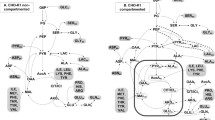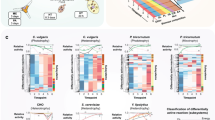Abstract
Hybridoma cells were grown at steady state under both reductiveand oxidative stress and the intracellular fluxes weredetermined by mass-balancing techniques. By decreasing the dissolved oxygen pressure (pO2) in the bioreactor, the reduced formof nicotinamide adenine nucleotide (NADH) was enhanced relativeto the oxidized form (NAD+). Oxidative stress, as a resultof which the NAP(P)+/NAD(P)H-ratio increases, was generatedby both the enhancement of the pO2 to 100% air saturationand by the addition of the artificial electron acceptorphenazine methosulphate (PMS) to the culture medium. It wasfound that fluxes of dehydrogenase reactions by which NAD(P)H isproduced decreased under hypoxic conditions. For example, thedegradation rates of arginine, isoleucine, lysine and theglutamate dehydrogenase flux were significantly lower at oxygenlimitation, and increased at higher pO2 levels and when PMSwas added to the culture medium. In contrast, the prolinesynthesis reaction, which requires NADPH, decreased under PMSstress. The flux of the NADH-requiring lactate dehydrogenase reaction also strongly decreased from 19 to 3,4 pmol/cell/day,under oxygen limitation and under PMS stress, respectively. Thedata show that metabolic-flux balancing can be used to determinehow mammalian respond to oxidative and reduction stress.
Similar content being viewed by others
References
Ardawi MSM & Newsholme EA (1984) Glutamine metabolism in lymphoid tissues. In: Häussinger D & Sies H (eds.), Glutamine Metabolism in Mammalian Tissues. (pp. 235–246) Springer-Verlag, Berlin.
Bonarius HPJ, de Gooijer CD, Tramper J & Schmid G (1995) Determination of the respiration quotient in mammalian cell culture in bicarbonate-buffered media. Biotechnol Bioeng 45: 524–535.
Bonarius HPJ, Hatzimanikatis V, Meesters KPH, de Gooijer CD, Schmid G & Tramper J (1996) Metabolic flux analysis of hybridoma cells in different culture media using mass balances. Biotechnol Bioeng 50: 299–318.
Bonarius HPJ, Schmid G & Tramper J (1997) Flux analysis in undetermined metabolic networks: The quest for the missing constraint. Trends in Biotechnol 15: 308–314.
Bonarius HPJ, Houtman JHM, de Gooijer CD, Tramper J & Schmid G (1998a) The activity of glutamate dehydrogenase is increased in ammonia-stressed hybridoma cells. Biotechnol Bioeng 57: 447–453.
Bonarius HPJ, Timmerarends B, de Gooijer CD & Tramper J (1998b) Metabolite balancing techniques versus 13C tracer experiments to determine metabolic fluxes in hybridoma cell. Biotechnol Bioeng 58: 258–262.
Bonarius HPJ, Houtman JHM, Schmid G, de Gooijer CD & Tramper J (1999) Error analysis of metabolic-rate measurements in mammalian-cell culture by carbon and nitrogen balances. Cytotechnol 29: 167–175.
Caroll RC, Ash JF, Vogt PK & Singer SJ (1978) Reversion of transformed glycolysis to normal by inhibition of protein synthesis in rat liver kidney cells infected with temperature-sensitive mutant of Rous sarcoma virus. Proc Natl Acad Sci USA 75: 5015–5021.
Chomczynski P (1993) A reagent for the single-step simultaneous isolation of ma, dna and proteins from cell and tissue samples. Biotechniques 15: 532.
Eigenbrodt E, Fister P & Reinacher M (1985) New perspectives on carbohydrate metabolism in tumor cells. In: Breitner R (ed.), Regulation of Carbohydrate Metabolism. Vol. 2 (pp. 141–169) CRC Press, Boca Raton.
Fell DA & Small JA (1986) Fat synthesis in adipose tissue. An examination of stoichiometric constraints. Biochem J 238: 781–786.
Ferrance JP, Goel, A & Ataai MM (1993) Utilization of glucose and amino acids in insect sultures: quantifying the metabolic flows within primary pathways and medium development, Biotechnol Bioeng 42: 697–707.
Follstad BD, Balcarcel RR, Stephanopoulos G & Wang DIC (1999) Metabolic flux analysis of hybridoma continuous culture steady state multiplicity. Biotechnol Bioeng 63: 675–683.
Greenbaum AL, Gumaa KA & McLean P (1971) The distribution of hepatic metabolites and the control of pathways of carbohydrate metabolism in animals of different dietary and hormonal status. Arch Biochem Biophys 143: 617–663.
Hornsby PJ & Gill GN (1981) Regulation of glutamine and pyruvate oxidation in cultured adrenocortical cells by cortisol, antioxidants, and oxygen: effects on cell proliferation. J Cell Physiol 109: 111–123.
Hothershall JS, Baquer NA, Greenbaum AL & McLean P (1979) Alternative pathways of glucose utilization in brian. Changes in the pattern of glucose utilization in brain during development and the effect of phenazine methosulfate on the integration of metabolic routes. Arch Biochem Biophys 198: 478–492.
Jan DHC, Petch DA, Huzel N & Butler M (1997) The effect of dissolved oxygen concentration on the metabolic profile of murine hybridoma grown in serum-free medium in continuous culture. Biotechnol Bioeng 54: 153–164.
Kilberg MS, Hutson RG & Laine RO (1994) Amino acid-regulated gene-expression in eukaryotic cells. FASEB J 8: 13–19.
Mitchell SL, Ross BD, Krick T & Garwood M (1989) Gas chromatographic-mass spectrometric analysis of hexose monophosphate shunt activity in cultured cells. Biochem Biophys Res Comm 158: 474–479.
Nyberg GB, Balcarcel RR, Follstad BD, Stephanopoulos G & Wang DIC (1999) Metabolism of peptide amino acids by Chinese hamster ovary cells grown in a complex medium. Biotechnol Bioeng 62: 324–335.
Lanks KW & Li PW (1988) End products of glucose and glutamine metabolism by cultured cell lines. J Cell Phys 135: 151–155.
Lin YY, Cheng WB & Wright CE (1993) Glucose metabolism in mammalian cells as determined by mass isotopomer analysis. Anal Biochem 209: 267–273.
Mancuso A, Sharfstein ST, Tucker SN, Clark DS & Blanch HW (1994) Examination of primary metabolic pathways in a murine hybridoma with carbon-13 nuclear magnetic resonance spectroscopy. Biotechnol Bioeng 44: 563–585.
Miller WM, Wilke CR & Blanch HW (1987) Effects of dissolved oxygen concentration on hybridoma growth and metabolism in continuous culture. J Cell Phys 132: 524–530.
Ozturk SS & Palsson BO (1990) Effects of dissolved oxygen on cell growth, metabolism, and antibody production kinetics in continuous culture. Biotechnol Progr 6: 121–128.
Reitzer LJ, Wice BM & Kennel D (1979) Evidence that glutamine, not sugar, is the major energy source for cultured HeLa cells. J Biol Chem 254: 2669–2676.
Savinell JM & Palsson BO (1992) Network analysis of intermediary metabolism using linear optimization. J Theor Biol 154: 421–454.
Schmid G & Keller T (1992) Monitoring hybridoma metabolism in continuous suspension culture at the intracellular level. Cytotechnol 9: 217–229.
Sharfstein ST, Tucker SN, Mancuso A, Blanch HW & Clark DS (1994) Quantitative in vivo nuclear magnetic resonance studies of hybridoma metabolism. Biotechnol Bioeng 43: 1059–1074.
Street JC, Delort AM, Braddock PS & Brindle KM (1993) A 1H/15N NMR study of nitrogen metabolism in cultured mammalian cells. Biochem J 291: 301–304.
Stryer L (1988) Biochemistry, 3rd edition. WH Freeman and Company, New York.
Vallino JJ & Stephanopoulos G (1989) Flux determination in cellular bioreaction networks: application to lysine fermentations. In: Sikdar SK, Bier M & Todd P (eds.), Frontiers in Bioprocessing (pp. 205–219) CRC Press, Boca Raton, FL.
Van 't Riet K & Tramper J (1991) Basic bioreactor design. Marcel Dekker, New York.
Varma A & Palson BO (1994) Metabolic flux balancing: Basic concepts, scientific and practical use. Biol Technology 12: 994–998.
Vriezen N & van Dijken JP (1998) Fluxes and enzyme activities in central metabolism of myeloma cells grown in chemostat culture. Biotechnol Bioeng 59: 28–39.
Xie L & Wang DLC (1994) Stoichiometric analysis of animal cell growth and its application in medium design. Biotechnol Bioeng 43: 1164–1174.
Xie L & Wang DIC (1996) Material balance studies on animal-cell metabolism using a stoichiometrically based reaction network. Biotechnol Bioeng 52: 579–590.
Zupke C, Sinskey AJ & Stephanopoulos G (1995) Intracellular flux analysis applied to the effect of dissolved-oxygen on hybridomas. Appl Microbiol Biotechnol 44: 27–36.
Author information
Authors and Affiliations
Rights and permissions
About this article
Cite this article
Bonarius, H.P., Houtman, J.H., Schmid, G. et al. Metabolic-flux analysis of hybridoma cells under oxidative and reductive stress using mass balances. Cytotechnology 32, 97–107 (2000). https://doi.org/10.1023/A:1008142218103
Issue Date:
DOI: https://doi.org/10.1023/A:1008142218103




